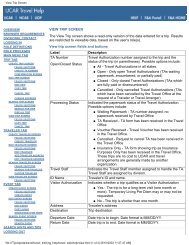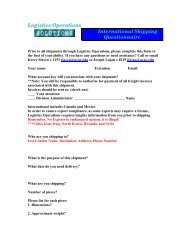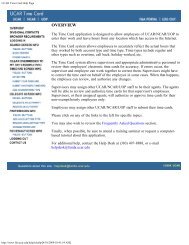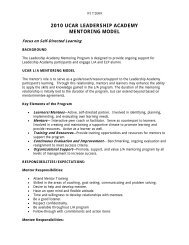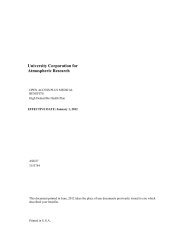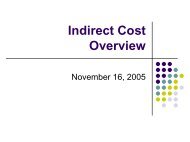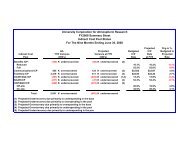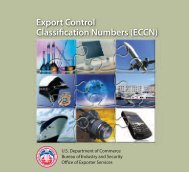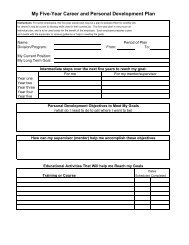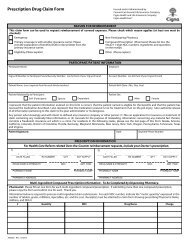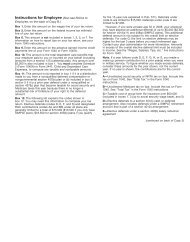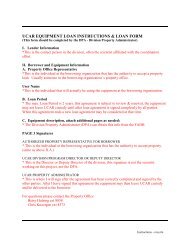Towards a Metrics Implementation Plan - UCAR Finance ...
Towards a Metrics Implementation Plan - UCAR Finance ...
Towards a Metrics Implementation Plan - UCAR Finance ...
Create successful ePaper yourself
Turn your PDF publications into a flip-book with our unique Google optimized e-Paper software.
3.2 National Research Council’s “Thinking Strategically: TheAppropriate Use of <strong>Metrics</strong> for the Climate Change ScienceProgram.” Committee on <strong>Metrics</strong> for Global Change Research,Climate Research Committee. National Academy of Sciences.At the request U.S. Climate Change Science Program (CCSP) the National Research Council(NRC) established a committee to develop quantitative metrics and performance measures fordocumenting progress and evaluating performance of global change and climate change research.This NRC report lays out the framework for creating and implementing metrics for the CCSP.The NRC document outlines the general principles for developing metrics that strongly advancediscovery and promote continuous improvement in the program.Drawing from the NRC report, thesidebar to the right lists the five typesof metrics, all of which should beincluded to result in a robust andcomplete metrics set. A bad metric,which may stifle growth, overburdenthe employees, and causeorganizational stress, obviouslyshould be avoided. A good set ofmetrics should assess process as wellas progress. Particularly, theimplementation and success of ametric set depends on three factors:(1) strong leadership to guide theprogram and apply metrics, (2) astrategic plan against which metricsTypes of <strong>Metrics</strong>Process <strong>Metrics</strong>: Measure a course of action taken toachieve a goal.Input <strong>Metrics</strong>: Measure tangible quantities put into aprocess to achieve a goal.Output <strong>Metrics</strong>: Measure the products and servicesdelivered.Outcome <strong>Metrics</strong>: Measure results that stem from useof the outputs and influence stakeholders outside theprogramImpact <strong>Metrics</strong>: Measure the long-term societal,economic or environmental consequences of anoutcome.are applied, and (3) the ability to guide strategic planning and foster growth in the organization.Furthermore, the metrics should be easily understood and broadly accepted by stakeholders. It isimportant to choose metrics and maintain a vibrant strategic plan so that both the metrics and theplan evolve in pace with scientific progress and program objectives.3.3 <strong>UCAR</strong> <strong>Metrics</strong> Committee ReportIn December 2002 a review panel appointed by NSF to evaluate <strong>UCAR</strong>’s proposal for themanagement of the NCAR recommended that “<strong>UCAR</strong>/NCAR should develop a robust set ofmetrics (beyond citation analyses) that characterize the quality, effectiveness and efficiency ofboth science programs and service functions.” <strong>UCAR</strong> management agreed with thisrecommendation, and subsequently appointed the <strong>UCAR</strong> <strong>Metrics</strong> Committee to conduct a studyand evaluation of possible indicators that would meet the challenge posed by the review panel.The “<strong>UCAR</strong> <strong>Metrics</strong> Committee Report” is the result of the work of the <strong>UCAR</strong> <strong>Metrics</strong>Committee.5




